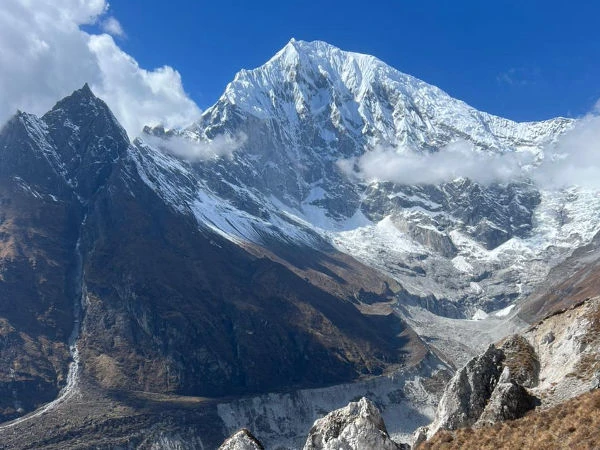The Everest Base Camp Trek is a ribbon of trail that stretches along the length of the Khumbu Valley in the Nepalese Himalayas leading to the most famous place in mountaineering history, Everest Base Camp. Many travelers every year during the Spring season (March to May) and Fall (September to November) fly into Kathmandu, Nepal to begin one of the best adventures that explores both the natural and cultural wonders that lie within the Everest region, home to Mt Everest (8,848m), and numerous other mountains in the world.
Once the choice has been made, and the trekking company has been decided on, there are some preparations necessary to ensure a safe and fun journey promising great memories and wonderful experiences. Let’s take a look at some details that will help prepare you for the trip of a lifetime.
Medical Clearance and Vaccinations
Medical Clearance
The first and most important conversation you need to have is that with your doctor. You must be physically able to withstand the physical challenges associated with trekking to Everest Base Camp. These are the information you should present to your doctor so that you can be medically cleared to undertake the journey.
The trek will last anywhere between 15 to 19 days depending on the itinerary you have decided with your trekking company. Each day will consist of up to 8 hours of physical activity, this includes walking on uneven, sometimes rocky, snowy, muddy, icy, or all the above-combined terrain. You will be carrying a small daypack with extra layers for warmth, and weather, as well as basic sundries, needed to protect against solar rays, along with water and snacks. Generally, your pack will weigh between 6 to 8 kg, but of course could always be more, or less depending on what you like to have access to throughout the day.
The gain and loss of altitude are significant in each day, where a typical day of trekking involves gain or loss of around 500 meters. This is all done at elevations well over 4,000m (3.3ft to 1 meter). The trekking primarily starts after a flight into Lukla which is at 2,840 meters and culminates with a side trip to the summit of Kala Patthar at 5,550 meters.
Medications
Once you and your doctor have discussed the routine of your possible activities, and you have been cleared, you may have questions concerning what types of vaccinations and/ or medications are important to stay healthy in Nepal. Medication questions should be a discussion between you, your trekking company, and your doctor and are beyond the scope of this article. You will read lots of suggestions, but please be careful as to who is doling out the advice and in what context. Too many times travelers have gotten into trouble with self-medication because of credentialed information. For instance, travelers have been taking a certain broad-spectrum antibiotic for traveler’s diarrhea, however, in Nepal, this medication has been used so pervasively that there are resistant bacteria now to this particular antibiotic.
Vaccinations
Image Source:https://www.unitypoint.org/homecare/filesimages/Articles/Infographic/Vaccinations-%20Not%20Just%20For%20Kids%20Infographic.jpg
As stated before, the best conversation regarding vaccination is between you, your trekking company and your doctor. Telling your doctor that you will be flying into Kathmandu, and spend a few days there and then trekking from sub-tropical forests up into alpine environments in Nepal is important. If your doctor doesn’t know exactly what you need, they will confer with colleagues to confirm proper vaccinations. However, at the moment there are no vaccinations legally required to enter or exit Nepal. Another important resource for considering vaccinations is the CDC website: https://wwwnc.cdc.gov/travel/destinations/traveler/none/nepal
Training
Training Progression
Next, you may be concerned about how to get your body and mind ready for the rigors of trekking to Everest Base Camp. As stated previously, the day to day activity includes 8 hours of physical activity on uneven terrain for at least 15 days at elevations above 3,000 meters. To train for the EBC Trek, the most important thing to remember is: training needs to be progressive. This means, do not go for a 10-mile hike uphill, with a fully weighted pack your first day, or you’ll be swearing off trekking forever. Rather, gradually increase your training program.
Endurance training should be the foundation. To prepare for a moderate trek you should begin training at least four to five months before your departure. Generally, an hour of aerobic exercise three to four times per week would be considered a minimum requirement. Adding some resistance training at least two times a week is preferred. Think gradual progression with all aspects of training. Ideally, the best preparation is hiking involving relatively steep ascents and descents. If you can manage a couple of valley floor to ridgeline ascents per hike with your weighted pack, albeit with stops along the way, you will cope with a moderately graded trek. “Speed is not important, stamina, confidence, and continuity are.”
Altitude
A little more about building your training program and the altitude you will encounter. You cannot train to make your body respond to the change in altitude, but what you can train for is the stress your body will be under and how you respond to it mentally. As you increase in elevation, the amount of oxygen available will decrease. This means your body will have less oxygen to carry out the work being asked of it. Your body goes through many physiological changes to compensate for this change, and during the process, you may experience a range of symptoms. These include but are not limited to:
- A headache
- Tiredness
- Disturbed sleep
- Loss of appetite/nausea
- Shortness of breath
- A cough
- Palpitation
- Swelling of the hands and face
Image Source:https://indiahikes.com/lack-oxygen-affects-treks/for-the-lack-of-oxygen-02-01-2/
This is called Acute Mountain Sickness or AMS. What fitness does help with is being more familiar with what feels normal, and how to handle physical stress. Exercising means you know what it feels like to be out of breath and how to calm yourself when feeling this way. Your best strategy is to take your time and drink plenty of water. Also, simple carbohydrates are known to help with acclimatization because the body needs lots more energy to do all the things it needs to adapt to lower oxygen levels. So it’s a good time to enjoy your favorite biscuits or cookies! These symptoms may not indicate the onset of AMS and if you experience them it does not necessarily mean that you should not continue. Group leaders should have extensive wilderness first aid training and it is vital you tell your guide or trip leader how you are feeling. AMS can progress to a more life-threatening condition, and your guide will know from your signs and symptoms if this is happening. Descent is the first line of defense if AMS is progressing to something more serious.
Gear and Clothing
Previously I mentioned the weather, altitude, how long the trek is and how many hours per day you will be trekking. So let’s look at clothing and gear. Your guide company will also provide you with a checklist, but here are the basics.
- Base Layer Tops and Bottoms (synthetic or wool)
- Day Pack (21L-35L)
- Day Pack Rain Cover
- Duffel Bag (No Wheels or Rigid Frames)
- Fleece Pants
- Fleece/Wool Gloves
- Fleece/Wool Hat
- Jacket or Sweater (non-cotton)
- Headlamp with Fresh Batteries
- Hiking Boots
- Hiking Pants (Convertible, Quick-Dry, Lightweight)
- Hiking Socks (Synthetic or Wool)
- Insulated Jacket
- Rain Jacket (Hooded, Lightweight, Waterproof, Breathable)
- Rain Pants (Lightweight, Waterproof, Breathable)
- Sleeping Bag (1°-14°, Lightweight, Compressible) Sunglasses (appropriate for high UV exposure)
- Sun Block and Lip Balm
- Sun Hat
- Water Bottles (Two 1-Quart) or Hydration System Plus
- Bandana
- Camp Towel
- Gaiters (Tall)
- Liner Socks (Synthetic)
- Personal Bathroom Kit: Toilet Paper, zip lock Bags, Personal Wipes, Hand Cleaner
- Personal First Aid Kit/Medications (Lightweight)
- Stuff Sacks
- Tee Shirts (Synthetic)
- Trekking Poles
- Down Booties (Colder Weather Travel Periods)
- Ear Plugs
- Electrical Adapter Plug and Converter
- Sleeping Bag Liner
- Solar Charger
- Water Purification Drops/Tablets
Not all of these items are necessary, but this list has been compiled by those who have had experience and it would probably be remiss if you didn’t have the proper gear. However, most of these items are required.
Summing up
The Everest Base Camp Trek is a phenomenal opportunity not to be missed. The scenery you will encounter is beyond words, and only those who have witnessed, and experienced the majesty of the Himalayas can really express the feelings they have inspired. Not only is the Khumbu Region of the Himalayan resplendent with incredible landscapes, but the cultural opportunities are also not to be missed. The chance to interact with traditional mountain cultures, though the modern world has completely enveloped them; they have retained their heritage, language, and religion superbly. To get ready for this trip of a lifetime should be a process to be relished. Enjoy the beauty, the wonders, and the magnificence of the Everest Base Camp Trek!
For booking your trip, or for further information on this trek, feel free to contact us.





